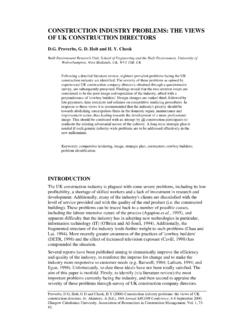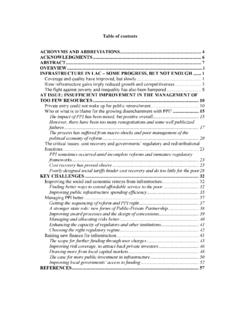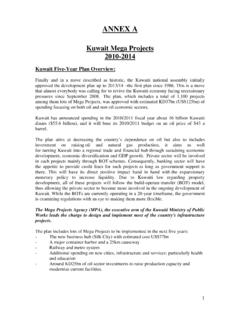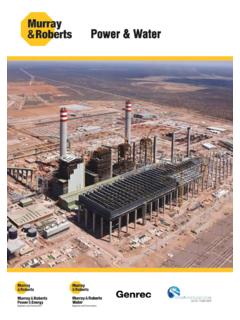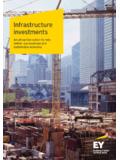Transcription of IDENTIFICATION AND CLASSIFICATION OF RISKS …
1 Xenidis, Y and Angelides, D (2005) IDENTIFICATION and CLASSIFICATION of RISKS in a new modelling process for build - operate - transfer projects. In: Khosrowshahi, F (Ed.), 21st Annual ARCOM Conference, 7-9 September 2005, SOAS, University of London. Association of Researchers in Construction Management, Vol. 2, 803-12. IDENTIFICATION AND CLASSIFICATION OF RISKS IN A NEW MODELLING PROCESS FOR build operate transfer PROJECTS Yiannis Xenidis and Demos Angelides Department of Civil Engineering, Aristotle University of Thessaloniki, Thessaloniki, 54124, Greece The Private Finance Initiative (PFI) procurement methods provide a framework for countries that lack the adequate own funds to develop major infrastructure projects. The build - operate - transfer (BOT) projects represent a variation of these procurement methods.
2 Success of these projects depends on the project agreement and, especially, the risk management during the whole life cycle. This paper contributes to the risk management of a successful BOT project by introducing a comprehensive new risk inventory and CLASSIFICATION scheme of BOT RISKS . The inventory comprises 86 RISKS , which are classified based on two criteria, their nature and the source of their origin. Each one of these criteria comprises several categories, which are explicitly presented and discussed. This CLASSIFICATION enables the assignment of RISKS to the project s life cycle phases, where they may occur, and the mapping of their interrelations; both are the next steps of the development process for a BOT fuzzy-based risk assessment model, which is also presented and discussed in brief.
3 The overall approach facilitates risk assessment and understanding in BOT projects and provides a clear risk framework, which is comprehensible by risk analysts as well as responsive to their demands. Keywords: BOT projects, Fuzzy theory, Life cycle, Risk. INTRODUCTION build - operate - transfer (BOT) procurement method for construction projects is one of the varying schemes for the development of public infrastructure with the partnership of the private and the public sectors. The reasons for a government to adopt the BOT scheme are: (a) lack of funding resources, (b) poorly equipped and organized domestic construction industry, (c) limited experience and expertise of the domestic workforce for certain types of construction projects, and (d) faster completion and operation of the project . All these constraints are successfully lifted under the BOT project development scheme because the project developers (concessionaire) undertake the funding and the technical and commercial RISKS for the development and operation of the project .
4 The concessionaire retains full control of the project until the end of a predefined time period called the concession period when it transfers the project back to the government. The undertaking by the concessionaire of all the RISKS associated with the project during the concession period is a major issue of concern for all parties involved, , the contractors, the sponsors, and the government. The success of a BOT project lies in the appropriate initial risk assessment by the potential concessionaire, which provides with the reasoning for a go or no go decision. Risk assessment determines Xenidis and Angelides 804the raising of funds, demanding of guarantees, and investment profitability for the concessionaire, and, eventually, the initiation of the project s development or not.
5 There are many risk assessment tools and techniques for BOT projects (Dey and Ogunlana 2004). However, they suffer from several limitations that prevent them from being generally applicable to all cases. Examples of these limitations are the focusing of the risk assessment approaches to specific project -types or specific stages of the BOT project development process. The modelling approach developed and highlighted here attempts to overcome these limitations by introducing 86 RISKS and their interrelations, which are possible to occur in any BOT project case. A new CLASSIFICATION scheme for these RISKS is adopted for the first time, which is based, concurrently, on the nature and the source of origin of these RISKS . This CLASSIFICATION assists the assignment of the RISKS to the phases of the project s life cycle and the modelling of the interrelations with a fuzzy theory based methodology.
6 The final product is a risk assessment tool that presents general applicability and comprehensibility by risk analysts, and assists the contractor to decide whether to enter or not into a given BOT project . STATE OF THE ART AND INNOVATION There have been many efforts to identify, classify and allocate RISKS , in a universally accepted manner, of BOT projects. For example Ogunlana (1997), Akintoye, et al. (1998), Charoenpornpattana and Minato (1999), Salzmann and Mohamed (1999), Wang, et al. (2000), Kumaraswamy and Zhang (2001), and Thomas, et al. (2003) have suggested a large number of RISKS associated to BOT projects and several CLASSIFICATION approaches for these RISKS . A comparative study of these efforts indicates that: (a) There is a consensus among experts on the existence of some RISKS in this kind of construction projects; however there are also many other RISKS that are considered as significant from case to case, leaving in this way, the risk inventory incomplete and not applicable to every project case.
7 (b) There are two prevailing approaches in classifying BOT RISKS , , either based on criteria of the nature of the RISKS ( financial) or based on criteria of the timing of potential occurrence in the life cycle. However, there are varying considerations among experts on definitions of both the nature of RISKS and the phases of the life cycle where these RISKS may occur. The abovementioned considerations indicate that there is a lack of a unified approach for BOT RISKS that prevents from the adoption of a comprehensive risk inventory and a CLASSIFICATION scheme that may be applicable in all cases of these projects. The contribution of this paper is the suggestion of a new risk inventory and CLASSIFICATION scheme for BOT projects to fill the gap. The significance and innovation in this effort lies to: (a) The comprehensiveness of the risk inventory, which includes 86 RISKS , identified and applicable to all types of BOT projects.
8 (b) The CLASSIFICATION of these RISKS according to two different sets of criteria, , the nature and the sources of origin. The result of this effort is the generation of a thorough risk framework for BOT projects that is applicable to the whole life cycle and is used for the development of a RISKS In A New Modelling Process 805risk assessment model based on fuzzy theory (not presented here due to space limitations). THE MODEL DEVELOPMENT PROCESS Figure 1 presents the development process of the BOT risk assessment model. The development process comprises five processes divided up into two stages. The risk IDENTIFICATION , CLASSIFICATION and assignment processes are parts of stage 1, while the mapping of RISKS interrelationships and modelling for risk assessment are parts of stage 2. An intermediate stage is the evaluation/validation of the first stage s results with the help of BOT experts, who responded to a questionnaire designed especially for the purposes of this research.
9 The same questionnaire is used for the assignment of values to the membership functions and the generation of rules of the fuzzy-based risk assessment model. Figure 1. The Development Process of a BOT Risk Assessment Model The model assesses the overall risk generated by the RISKS and their interrelationships in the sub-phases (in total 23) of the BOT project s life cycle phases (in total 6). Then the relation between the several sub-phases in the life cycle is considered in order to assess the overall project s risk. Therefore, the life cycle phases and sub-phases constitute the risk propagation path in this risk modelling approach. An important parameter is that the life cycle is considered in relevance to the presence of the concessionaire; this means that the life cycle ranges from the sponsor s preparation to bid to the transfer of the project back to the state.
10 The process of assigning RISKS to the sub-phases of the BOT project s life cycle phases is based on the assumption of the time period where a possible occurrence of each risk should be expected. Therefore, there are RISKS assigned to more than one sub-phase inside the same phase or in more than one phase. The risk assignment process is also validated by the responses of the experts to the questionnaire. IdentificationRisk InventoryFuzzy InferenceDefuzzificationFuzzy Logic ToolboxQuestionnaireSource of OriginLit eratureReviewProject CasesOwn InputRisk IDENTIFICATION ProcessNature of RiskRisk CLASSIFICATION ProcessEvaluation/Validation of Stage 1 Stage 1 Sub phase 1 Sub phase i-1 Mapping of RISKS InterrelationshipsRisk Assessment ModelStage 2 Sub phase 2 Sub phase iRisk Assignment ProcessRisk InventorySub phasesMembership functionRules generationXenidis and Angelides 806In this paper the focus is on the risk IDENTIFICATION and CLASSIFICATION processes of the first stage.






